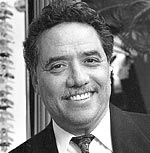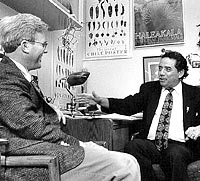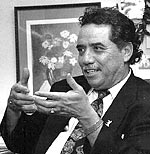Interview: Eloy Rodriguez

Eloy Rodriguez works at the interface of biology and chemistry. As one of the world's leading plant chemists, Dr. Rodriguez searches for molecules in plants and insects that function in defense. He and his colleagues have also invented the field of zoopharmacognosy, the study of how wild animals use plants for possible medicinal purposes. We visited Dr. Rodriguez in his research greenhouses at the University of California, Irvine. He has since moved to Cornell University, where he is James A. Perkins Professor of plant biochemistry and natural products biology. His comments in this interview highlight the multidisciplinary character of biology.
When we came in, we noticed that your facility is called Phytochemistry and Toxicology. Let's start with the phyto- chemistry part. Tell us about this field.
The simplest translation of phytochemistry is plant chemistry (phyto meaning plant). Phytochemistry is the study of the chemicals produced by plants, especially the so-called secondary chemicals, or secondary compounds. Unlike primary compounds, molecules such as sugars and chlorophyll that all plants produce and require for normal growth, secondary compounds are molecules without known functions in the basic processes of life. Each secondary compound is unique to certain plant species. Secondary compounds were originally thought of as waste products, but as evolutionary biologists got involved in studying the function of these chemicals, they began to see them as very important to the survival of plants. Some secondary plant compounds are very familiar to us. Aspirin, for instance, was originally derived from willow trees before it was synthetically made. Caffeine is not only a stimulant for humans; it also has physiological effects on fungi. These substances are small molecular compounds that function mainly in defense for the plants.
How do secondary chemicals help defend plants?
Natural selection favors those plants with the right kinds of chemical compounds to ward off fungi, viruses, insects, and large herbivores. There is a large array of organisms that eat plants, and a plant can't just get up and run. A plant's ability to survive is really due to chemistry—the ability to have an effect on the physiology of an organism. An animal will eat a plant and then either become paralyzed or otherwise impaired by the secondary compounds, or it will escape and learn to avoid that plant in the future. Dead plants don't reproduce, so obviously the presence of defensive compounds allows for fitness and reproduction within a given population.
Secondary compounds aren't just randomly produced and packaged in the plant. Flower chemistry is very different from leaf chemistry, which is very different from root chemistry. In flowers you wouldn't expect to find a lot of poisonous chemicals; you would expect to find chemicals that attract pollinators. And that's what flowers have—nice perfumes and pigments. They generally aren't very toxic. But when you get into the leaf, that's where you begin to see a large diversity of alkaloids and other toxic compounds. There are different kinds of chemistry in different parts of a plant, which makes sense from an evolutionary perspective.
The creosote bush is a really interesting example. This is a desert plant that's found all the way from South America to Utah and north. If you ever see a creosote bush, it just glistens in the sun because it's coated with a very thick resin that protects against extreme radiation, something you have to worry about if you're a desert plant. It also helps prevent critical water loss through transpiration. It's an incredible plant as far as the ability to make compounds; we've calculated that this plant has over 500 secondary chemicals! Chiles are another intriguing case. Chiles are South American in origin and became an important food for the Aztecs and indigenous groups of Mexico, and now Asia is the biggest consumer of chiles. Studies have shown that chiles are very good antibiotics. In fact, I had some school kids do an experiment where they put chiles on bread and found that it took longer for fungus to grow on the chile-coated bread than on plain bread. I'm still studying the chemistry of chiles; the alkaloid chemistry is quite fascinating.
The chemistry part of what you do sounds like lab work. Does your research get you out into the field as well?
I was trained as a plant biologist and as an organic chemist. A lot of people can get pretty focused and pretty reductionist in their approach, but I have always had a very broad biological and chemical background. When I do chemistry, I don't just do it for the sake of chemistry. It's exciting to look at new chemical structures, but I have always wanted to understand the reason for their existence. To do that you have to get out in the field. You have to go out, make observations, see the system, and ask the question, "What is the function of this chemical?" A lot of my research starts from going out in the field and observing.
Can you give an example?
One project that I got involved with has now developed into a discipline. It's called zoopharmacognosy, the study of how animals possibly medicate themselves with plants. This came about from real observations. It started with looking at general feeding behavior in great apes and the family of chimps. My colleagues and I observed some very peculiar things going on that had to do with apes selecting certain plants and swallowing the leaves. I don't think we ever would have discovered this if we hadn't been out there looking at these animals. The fieldwork was essential. I still go down to the rain forest every summer. It is an integral part of the way I do science.
 Tell us more about finding medicinal plants by following animals.
Tell us more about finding medicinal plants by following animals.
I got involved with Richard Wrangham, a primatologist from Harvard who was studying the feeding behavior of primates in the Kibale Forest of Uganda. We were interested in the notion that monkeys are able to eat more poisonous plants than chimps. That was the original general hypothesis-that monkeys have a greater physiological ability to deal with toxins. If you go out in the rain forest, you'll see monkeys eating all kinds of stuff that chimps will avoid. If you're ever starving to death in the rain forest, don't follow the monkeys, follow the chimps!
We followed chimpanzees that were sick. Apes get every illness that we do, and you can tell when they are sick. Animals that are very sick will focus on one particular plant species and stop eating everything else. In one observation, researchers followed a particular animal for several days, and for two whole days this animal concentrated on one plant species. It wouldn't eat the whole plant. It would take off the leaves, crack the stalk, and then suck out the juice. The scientists then did some beautiful chemistry that showed that the leaf chemistry was totally different from the stem chemistry. It was a clear example that animals were selecting a certain part of the plant that had the proper chemicals. I think it's pretty clear that these plants we are calling the pharmacopia of the apes are very good ones.
Richard pointed out to me that sometimes chimps seem to select young leaves from certain plant species. From his earlier studies in Africa, he showed that these animals get up in the morning, make a beeline toward these plants, and take a certain amount of the young leaves. We calculated that they were more or less getting a set dosage of the drug or drugs in the leaf. Once we put that together, we published a paper. The response we got was incredible, from both scientists and nonscientists. It's like everyone who owns a dog or cat was telling you that they should be part of this discovery. I think science should always do that—involve people.
This kind of science really catches the imagination of everybody. It's kind of interesting how this field has really exploded in the sense that a lot of scientists from other disciplines are asking questions. Behavioral scientists are no longer just going out, looking at animals, and saying, "Well, the plants are there for food." They now have to look at another component indicating that plants might also have an effect on reducing the parasite load. In the area of phytochemistry, a result of this new field is that there is now a more direct way to go after plant parts to look at the chemistry. A lot of collection is done randomly—you go out and collect a bunch of bark, for example. It is a very tedious and not exactly a very scientific way to go about getting drugs. It's nice when you have animals basically telling you, "Here, try these leaves." Of the 15 plant species that we have looked at while studying these chimps, we have figured out the chemistry of five of them. When you figure out a chemical structure, you are breaking a code of nature. That code gives you all the information. It says, "Look at me, look at my triple bonds. Do you see what I can do with these triple bonds?"
Have apes and other animals led you to any compounds that have potential medicinal value in humans?
Oh, clearly. I certainly see some potential in modern medicine. For example, some of the compounds we've identified by zoopharmacognosy kill parasitic worms, and some of these chemicals may be useful against tumors. There is no question that the templates for most drugs are in the natural world.
How do you think people of ancient cultures, including Native Americans, first identified medicinal plants?
That is really still the sixty-four-thousand-dollar question! Besides trial and error, there must have been some experimentation taking place and some very keen observation. Now, when I go out to the tropical rain forest I always ask the people, "Do you look at animals?" and they will tell me, "Oh yeah, sure we look at animals." Some of them even keep animals in captivity and feed them plants. I am not implying that they use animal experimentation the way we do, but pets are an interesting idea. I mean if you keep pets, you may as well learn something from them.
I think the use of medicinal plants started when the first humans got sick. When you are sick, you try to figure out how to take care of yourself. We are talking about a long history of drug development and drug use. When the Europeans came to the New World, they not only brought a lot of destruction, they also brought a lot of disease. Indigenous people tried to use some of the medicinal plants to deal with these new diseases. For example, malaria was probably brought to the Americas from Africa, through the African slave trade. Quinine was discovered in Peru, and native people there were probably already using it to treat fever related to other diseases when malaria was introduced.
Anthropologists have documented that native people extract plant materials, grind them up, filter them, and treat them with burned leaves (which act as a base)- almost the same process that I use. They get out materials that are relatively pure for use as medicine. This is not a crude process. These people don't run around grabbing leaves and sticking them in their mouth or just boiling them and then drinking the tea. It is a lot more sophisticated than that. Indigenous people have been extremely successful! They have really filtered out some of the best medicines from plants. A lot of the drug companies started out thanks to those folks.
Is the medicinal potential of tropical plants among the incentives for conserving the biological diversity of rain forests?
There is no question that diversity, any kind of diversity, is worth keeping. In the tropical rain forest we are talking about the ultimate diversity in plants, animals, fungi—life! The arguments that have been made for preserving the forests are excellent, ranging from production of oxygen to the fact that we now have good evidence that the rain forest plays a very important role in the uptake of excess CO2. The more we search the rain forest, the more in awe of it we are. We see how important it is.
Then there is the argument that, "Well, you know, we can't get rid of this genetic material because how are we going to cure cancer?" But the importance of the rain forest goes beyond human concerns. We are talking about the health of the planet.
One way I am trying to increase awareness in college students is by taking a few undergraduates each summer into the rain forest. The students come back with a passion like you have never seen before. I wish there was a major undertaking among all universities to do this. I think it would give a big boost to ecology. Students are very good communicators, so they will spread the word!
 What experiences did you have as a student that led you to a career in science?
What experiences did you have as a student that led you to a career in science?
I grew up in South Texas, in a very poor but typically large family. I had 67 cousins. Sixty-four of us got undergraduate degrees, and ten of us got master's degrees or Ph.D.s, which was unique. I grew up in a predominately Mexican-American community so I am bilingual. I never lived in Mexico, but my parents maintained my Spanish. It is the greatest thing that happened to me as a researcher because it allows me to communicate with all of South America, which is over 400 million people.
I grew up in a strong community where the value of education was obviously very important. We knew we couldn't get good jobs unless we got an education. The community was so poor that you couldn't be a criminal. There was no profit! What are you going to do, steal from the poor? That didn't make sense. If you stole a car, you probably got into greater debt trying to fix the darn thing! We saw that the people who seemed to be the best off were teachers. They were the ones with Ramblers and brick homes.
My interest in science started with visits to my grandfather in Mexico. He had a ranch—a small farm, actually. He would always take me out and show me animals and plants. I was intrigued with them, and I think it just stayed with me. I always wanted to be a scientist. I never thought about medical school. Maybe it has to do with the fact that we had a pretty lousy medical doctor. That may have been the reason—he never seemed to cure us!
Certainly my study of medicinal plants has to do with my roots. The only kind of medication that we used to get, I remember very clearly, was people bringing in herbs (primarily women did this). My aunt always maintained a little medicinal garden in the backyard. I was never negative about this because it was the only kind of medication that we used. You can't be negative about what cures you, and it obviously cured me because I am here! The more I think about it now, the more I realize the value of those herbal treatments. I know now that the reason these plants work is because they have certain chemicals in them that work.
Is that what led you to phytochemistry?
I went to the University of Texas, and as an undergraduate I felt very lonely. I was one of the very small number of minority students. There were no programs for minority students. We were kind of abandoned. It was like shopping at a 7-11 store-you know, just get your stuff and get out. That was my experience until I got hooked.
I was in a work-study program and they needed somebody to mop the labs. That's how I got started in the laboratory. There was a post-doc from Switzerland who was a nice guy, but kind of a lazy guy. He wanted someone to help him in his lab performing chemical separations. He said, "Can you do it?" and I said, "Sure." I was really good at it. He always used to be out with his coffee reading his newspaper at the desk. One day the professor in charge of the lab came in and asked, "What's going on?" That is how I got my first publication. I published two more papers as an undergraduate and fifteen more as a graduate student. I worked hard and loved what I was doing. The research bug got to me, the passion, the excitement of science. Once it gets to you, you can't let go of it.
Based on your own experiences in science, what advice can you share with first-year biology students?
I always tell undergraduates that it's okay to become a specialist, but when you're an undergraduate, give yourselves some breadth of experience. As an undergraduate, I started as a zoology major, then I went into botany, and then organic chemistry. But I never really could separate them. Never in a lifetime would I have stumbled across the idea of zoopharmacognosy if I had just been stuck within an isolated field of organic chemistry. But if you talk to organic chemists now, they talk constantly about biology. This area is wide open today; there's a rebirth of excitement in looking at natural products. You can't separate the chemistry from the biology. I say this so young students realize that the interdisciplinary approach is the way things are going.
©2005 Pearson Education, Inc., publishing as Benjamin Cummings